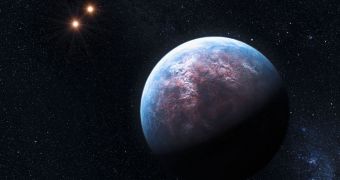According to the conclusions of a new scientific research, it would appear that the surface of extra solar planets orbiting binary star system may be covered in trees that are black, rather than the usual green.
This is equally true for all forms of vegetation, the researchers who conducted the new work say. They explain that the color these organisms have is entirely dependent on the type of light they work with.
The chemical that gives leafs here on Earth their green color is called chlorophyll, and its main role is to act like a catalyst in photosynthesis. This process is responsible for converting sunlight and carbon dioxide from the atmosphere into oxygen and energy for the plants.
Photosynthesis is widely believed to have been what allowed for the Great Oxygenation Event to take place, hundreds of millions of years ago. Without this event, complex life would have still been impossible on our planet.
The same may hold true for alien worlds as well, in the sense that this critical natural process may affect exoplanetary habitats as much as it did here. However, the trees, shrubs and plants that will be carrying out photosynthesis will be colored in black, or maybe gray.
“If a planet were found in a system with two or more stars, there would potentially be multiple sources of energy available to drive photosynthesis,” explained University of St. Andrews in Scotland expert Jack O'Malley-James.
The expert, who is also the lead author of the new investigation, added in a statement that “the temperature of a star determines its color and, hence, the color of light used for photosynthesis.”
“Depending on the colors of their starlight, plants would evolve very differently,” the expert adds, quoted by Space.
He said that the reason why plants on Earth appear green to us is because they absorb light in the blue and red portions of the electromagnetic spectrum, while at the same time reflecting green light back.
This makes perfect sense from a physics perspective, as blue light is very energetic, and red light is produced in massive amounts by the Sun. Therefore, there is nothing to drive plants towards developing the ability to harvest green light.
But this situation could be reversed on other planets, and especially on those around binary systems. The wavelengths that are available to drive photosynthesis at those locations could vary considerably from the ones the Sun produces.
As such, vegetation may range in color from orange and blue to gray and black.
“Plants with dim red dwarf suns, for example, may appear black to our eyes, absorbing across the entire visible wavelength range in order to use as much of the available light as possible,” the expert revealed.
He made a presentation of the new study results on Monday, April 18, at the national meeting of the UK Royal Astronomical Society, in Llandudno, Wales.

 14 DAY TRIAL //
14 DAY TRIAL //